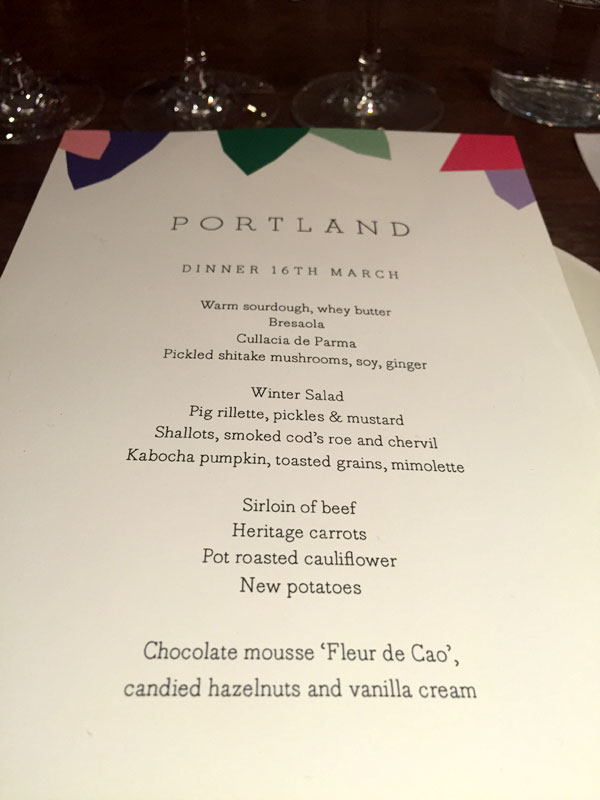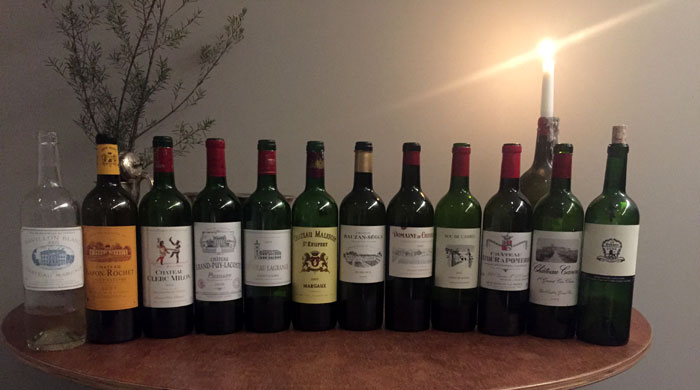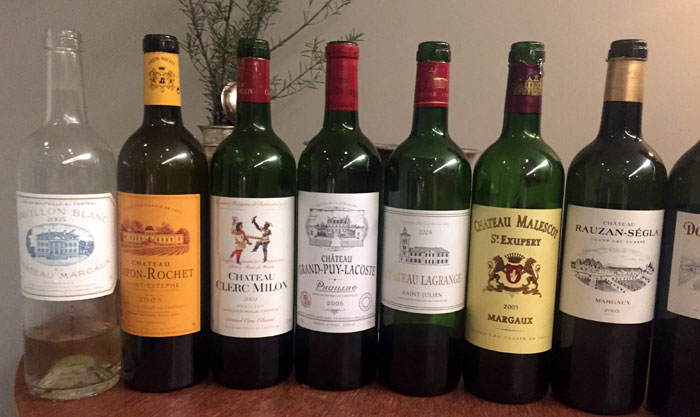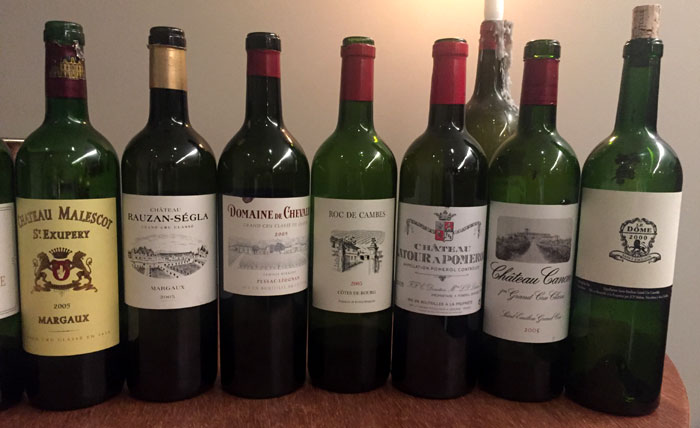Last week, a few of us from the wine trade got together in Portland restaurant’s private dining room to taste through a range of Bordeaux 2005s. Winemakers often refer to 2005 as the deck chair vintage because, from bud burst to harvest, the conditions were so perfect that they could pretty much sit back and watch the grapes ripen all by themselves. As a result, the wines that were produced were almost universally outstanding on both sides of Gironde.
Even though the en primeur release prices of the 2005s were the most expensive ever for wines offered whilst still in the barrel (until they were surpassed by the twin vintages of 2009 and 2010), the great thing for consumers was that you didn’t have to spend silly money to get something truly special. In fact, if anything, the exceptionally high quality was even more evident at the low to middle end of the spectrum where the wines really over-performed and, it would be fair to say, that virtually not a bad wine was made.

The delicious menu specially created for the private dining room.
|
With that in mind, we set the theme as ‘Bordeaux 2005 under £50 per bottle en primeur’ because, thanks to the relative affordability, these are the wines that one is more likely to be drinking on a regular basis over the coming decades. It was also agreed that, if nothing else, wines at this quality level would be more approachable at this stage of maturity.
As luck would have it, the line-up consisted of at least one wine from each of the major communes and, for good measure, there was even a Côtes de Bourg red and a white from a very famous château included. The food for the evening was already taken care of thanks to Portland’s private dining menu so, as soon as we had all arrived, we got cracking on the white while we waited for the first course of mixed starters to arrive.

The full line-up in the exact order of tasting, including a bottle of Le Dôme 2000 for good measure.
|
Pavillon Blanc de Château Margaux 2005 (released at £37, now at £100) (93 points, Robert Parker)
Mildly oxidative on the nose, this initially seemed like it has seen better days. However, with time in the glass and enjoyed with some food, this did reveal the rich, ripe stone fruit characteristic of a warm vintage. Bordeaux does make some stunning dry white wines but, from what I’ve experienced so far, I much prefer them when they are young, fresh and vibrant. 15 points
Lafon Rochet 2005, Saint Estèphe (£16/£28) (91, RP)
A pure, ripe nose of blackberries, cedar, spice and cigar smoke. This was quite firm and angular as you would expect from a traditional St. Estèphe property. However there was enough sweet fruit on the palate to balance the earthy, gravelly notes and the austere tannins. Proper claret. 16.5 points
Clerc Milon 2005, Pauillac (£23/£45) (93, RP)
Quite an open nose that hinted at plums and chocolate as well as a hint of cedar. On the palate this was quite poised and restrained but, at the same time, well-balanced and elegant. 17 points
Grand Puy Lacoste 2005, Pauillac (£35/£65) (92, RP)
A sexy nose of pure, sweet cassis framed by hints of cedar, oak and spice. The sweet fruit continued on the palate which plush, silky and yet so fresh and perfectly balanced. The ripeness made me think of 2009 but with more freshness and finesse. This was definitely my wine of the night! 18.5 points
Lagrange 2005, Saint Julien (£23/£33) (91, RP)
With an aromatic nose of cedar and oak there was initially more wood than fruit on the nose. However it eventually revealed a hint of sweet black fruit in the background. On the palate it was quite structured but hinting at some juicy, sweet fruit that gives this great potential.16.5 points
Malescot Saint Exupéry 2005, Margaux (£30/£68) (96, RP)
A very ripe, rich, opulent nose – more California than Margaux for me. A touch over-ripe and over-extracted and slightly lacking in elegance and definition of the others. Although its considerable puppy fat made this rather ‘quaffable’ it would need time to resolve the firm, tannic finish. 16 points
Rauzan Ségla 2005, Margaux (£40/£66) (93+, Parker)
A very classy and sophisticated nose of blackberries and cedar. Some sweet, juicy fruit on the mid-palate. Bright, fresh, long, pure and elegant on the finish. Well-crafted and it could do with another five years to reach its peak. The most noble of all the wines this evening. 18 points
Domaine de Chevalier 2005, Pessac-Léognan (£24/£48) (95, RP)
This immediately seemed really open and accessible with an attractive nose of black plums and cassis. With 35% Merlot this really came across as soft, plush and really well-balanced. Thanks to the freshness and softness this struck me as one of the most drinkable wines tonight. Another success from this consistently over-performing château. 18 points
Roc de Cambes 2005, Côtes de Bourg (£25/£32) (92, Neal Martin)
As you might expect, this was opulent, exotic and hedonistic. There was still quite a bit of new oak framing the ripe, fruity nose. On the palate it was full-bodied, plush and whatever tannins were there had totally been absorbed by the sweet, ripe fruit. I love Roc de Cambes and this did not disappoint. 17 points
Latour à Pomerol 2005, Pomerol (£37/£48) (94, RP)
Sadly this wasn’t a great bottle as it came across as a bit green and leafy when, by all accounts, it should have been gorgeously fruity, rich and textured. Not scored
Canon 2005, Saint Emilion (£41/£65) (93+, RP)
A really ripe and intensely concentrated nose of sweet black fruits. An intense, plush and mouth-coating palate and a very long, sweet, ripe finish. Unlike the Malescot, which had similar levels of intensity and concentration, this had real balance and freshness in spite of the undeniable opulence and richness. 17.5 points

My wine of the night was Grand Puy Lacoste but Clerc Milon and Lagrange showed promise.
|
After tasting this wonderful selection of wines, I am pleased to confirm that they are every bit as good as the hype and scores suggest. I remember being blown away by the 2005s when I tasted them in 2008, not long after they had been shipped from Bordeaux. Now that they have had some time to settle down and soften in the bottle, they are even more complete and are hinting at their future potential. As Robert Parker said at the end of 2014, “the greatness of this vintage is increasingly apparent as the wines throw off their cloaks of tannin”.
All of the wines exhibited the sweet, ripe fruit that you would expect from a warm, dry vintage but my overall impression was how fresh they were (thanks to the acidity) and the resulting sense of balance they displayed as a result. 2005 is very much a classically-styled vintage (in contrast to 2009) but one of exceptionally high quality. Although 2009 and 2010 have been in the limelight over the past five or so years, there is no doubt that 2005 joins 2009 and 2010 as three of the greatest vintages of the modern era.
In terms of the quality of wine on offer, there were no surprises. However, the one thing that was unexpected was how drinkable many of these wines were right now. Admittedly, all of the bottles had been double-decanted and partnering them with food really made them come into their own. Unlike the 1982s and 2009s, which were delicious from release, I really expected the 2005s to need a good 15 to 20 years to come round. All the wines, with the exception of one or two, were drinking perfectly on the night but it was quite apparent that, like all great vintages, the best was still yet to come and that there was certainly no rush.

The stand-outs here were Rauzan Ségla, Domaine de Chevalier, Roc de Cambes and Canon.
|
In France, they tend to drink their wines on the young side but in the UK, where we have developed le goût anglais, there is a tendency to forget about your wines in storage until they are fully mature. Undoubtedly, some of the greatest wines I have ever drunk have been perfectly matured examples of First Growths and Grands Crus from legendary vintages but I have also taken a lot of pleasure from young wines which are full of bright, fresh fruit and in the prime of youth.
So, in conclusion, if you have a few cases of Bordeaux that cost you £50 per bottle or less en primeur, why not take delivery of one or two of them today and see how impressive and delicious they are right now. Yes, they will be even better in five, 10, or even 20 years’ time but the only way to measure their greatness is to track their evolution over time. There is something inherently fascinating and satisfying in witnessing a wine develop and improve in the bottle. In my opinion, it makes much more sense to enjoy a case of wine over a decade or so than to be forced to condense your drinking into a couple of years, having discovered that the wine is fully mature and quickly going downhill!